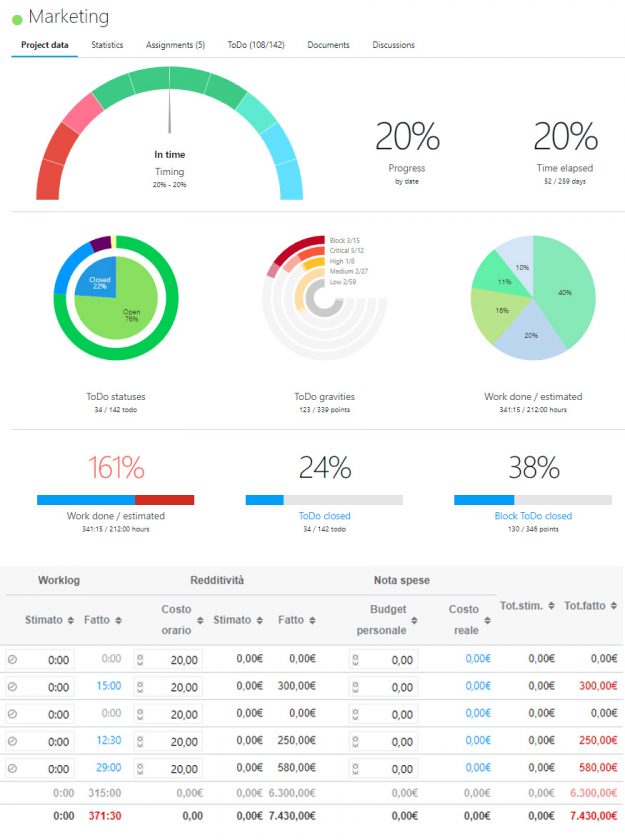Gap Analysis is one of the most powerful tools available to Project Managers and more. If used correctly, in fact, it can really help a company correct its course and avoid catastrophic mistakes.
CONTENT
- What is a gap analysis?
- Benefits of performing a gap analysis
- Benefits of Gap Analysis: Product Portfolio Opportunities
- Benefits of Gap Analysis: Process Improvements
- Benefits of Gap Analysis: Profit Improvements
- How to perform a gap analysis
- Identify areas to improve
- Analyze the present status
- Define the ultimate goal
- Understand the gap
- Establish an action plan
- The support of a smart tool
You’ve probably already heard about it but you’re still confused on the subject and today, with this article, we’re going to try to straighten out all the doubts on this matter.
Every business strives to grow and thrive, but what happens when you fail to achieve the desired results?
This gap between desired and actual results suggests that it’s time to perform a gap analysis.
What is a gap analysis?
A gap analysis is a formal study of what an organization is currently up to, where it wants to be, and how is it possible to close the gap between those two aspects.
The need for a gap analysis usually originates from a gap, a shortcoming.
Perhaps the sales team missed their goals? Or customer service turnaround times are too slow and customers complain?
However, it can also come from proactive leaders who want to understand how to improve the chances of success before embarking on a new strategy.
This analysis can be carried out from a number of perspectives, and as a result, there are different types of methodologies for a gap analysis. Here are the four main ones:
- Strategic gap analysis: Attempts to understand why certain performance targets were not met.
- Product gap analysis: this analysis examines the organization’s position in the market to estimate the gap between actual and projected sales.
- Workforce gap analysis: examines the variance between the required and actual number of employees.
- Profit gap analysis: examines the gap between actual and targeted profit.
Gap analysis can be applied to a department’s or team’s performance, an individual’s performance, or an entire firm’s performance.
Whenever goals are not met, it’s time to take a closer look at what could be an obstacle through gap analysis.
Benefits of performing a gap analysis
A gap analysis enables an organization to operate at its maximum potential. Here’s how this tool can help:
Benefits of Gap Analysis: Product Portfolio Opportunities
Through gap analysis, you can review your current portfolio of products and services to determine new opportunities.
Since it’s common for some sort of gap to exist between customer needs and a company’s offerings, a gap analysis helps you identify these areas to determine if you want to develop new offerings to fill this “gap”.
Benefits of Gap Analysis: Process Improvements
A gap analysis can pinpoint areas for improvement within an organization’s operations.
If, for example, the administrative department fails to pay invoices in a timely manner, a gap analysis can identify opportunities for process improvement.
Benefits of Gap Analysis: Profit Improvements
If profit goals were not met, conducting a gap analysis to find out what went wrong can help solve the problem.
For example, this analysis can ascertain if there were problems with the forecasting method that set wrong profit goals, if unexpected competition took away business, if costs increased, or other reasons.
How to perform a gap analysis
The following gap analysis model helps to pinpoint the difference between reality and business goals, thereby effectively making it easy to discover where there is room for growth.
This model can be applied to the entire organization or to a single process.
Identify areas to improve
The first step is to understand where you want to apply a gap analysis model and what you want to get out of it.
After that, you can then assess what type of gap analysis you want to apply to the given situation.
Perhaps you want to improve the efficiency of an existing operation? In this case, a performance gap analysis will be helpful.
Maybe you are trying to determine if you need to hire more staff? In that case, you should choose a workforce gap analysis.
Analyze the present status
After having identified where a gap analysis is needed and the purpose of said analysis, you need to analyze where you are now.
By examining the present state, you will determine the baseline for improvement.
For example, if customers are complaining about slow response times, you need to know what those response times currently are.
Report everything that led to the current state thoroughly in a document.
Define the ultimate goal
After understanding where you are currently, it’s time to set measurable goals to aim for.
The ultimate goal should be an improvement over the current state and should be measurable so you know when you will achieve it.
One way to determine the ideal future state is to look at industry standards or the level set by your competition.
Another approach is to look at the organization’s past data and base the ideal future state on those numbers (check the article about lessons learned).
Another solution is to use employee or customer feedback to understand the end state you should create. For example, customers might say that a key feature is missing in the products, so here’s where the goal can be to develop just that feature.
Understand the gap
The present state has been analyzed and the future goal has been established; now you need to compare these two to understand the gap you are trying to close.
This may be small and some minor changes to an existing workflow may suffice, but the gap could also involve major organizational changes that require a change management process.

This is the time to learn what obstacles you are trying to overcome.
Establish an action plan
Now is the time to set an action plan to close the gap.
This step focuses on filling out recommendations and obtaining consensus from relevant stakeholders.
To wrap up, a gap analysis crystallizes the challenges to overcome and puts in place solutions that will be able to bring an organization to the desired final state.
It is essential to emphasize that you should not spend too much time on the gap analysis, but only spend as much time as is necessary to efficiently complete the analysis.
It will be more useful to be able to quickly move on to the action plan and turn the company into a maximally optimized business.
The support of a smart tool
Since the plan can be cumbersome, the help of a project management software in project planning can help in turning the ideas into a concrete and executable project plan.
Twproject is the best existing software that allows, among its various functions, to carry out precise analyses on the development of your projects. In fact, it monitors progress in real time, taking into account different progress factors, such as:
- The distribution of the workload among the project participants, in percentage.
- The progress in carrying out assignments (ToDo) and their subdivision by status and severity.
- The trend in the budget, dividing between estimated and actual personnel costs and ancillary costs, also estimated and actual.
- The percentage of work done compared to the initial estimate.

With its graphs and reports, Twproject clearly shows you the gap between estimated and actual progress and this is very useful if you want to carry out gap analyzes in terms of performance and profit.
If you want to do a free trial our team will be on hand to show you how to set up your analyses. Don’t waste any more time and get started now!



